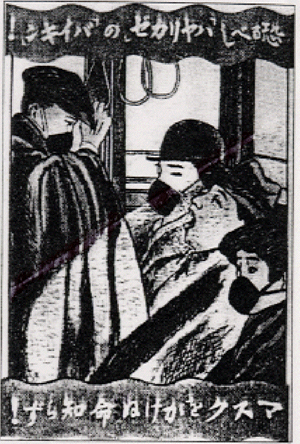Walk around Japan for even a day, and you’re bound to notice people with colds or allergies wearing masks to cover their mouths. Historically, these have been cheap, plain white disposable masks. But lately, a new kid on the block has brought a fashionable twist to this old classic.
Why Masks?
First, let’s step back and ask: What’s with the masks, anyway?
Masks have been used as a strategy to prevent the spread of illness in Japan for at least 100 years. According to Web site NetLab, masks came into popular use during the “Spanish Flu” influenza epidemic of 1918 to 1920. The killer epidemic left tens of millions dead worldwide. At one point, it infected half of Japan’s population. Posters at the time warned, “You can’t live without a mask!” (マスクをかけず命しらず!)

As a result, despite their limited effectiveness, masks remain in popular use to this day. Indeed, a run on masks during 2009’s Swine Flu epidemic sparked a national shortage. Indeed, mask sales in 2017 surpassed 2009’s levels.
海外では通じない日本の常識? 日本がこんなに”マスク大国”になった理由
先日、 朝日新聞が報道した 、青森県むつ市役所の「マスクなし対応」に、ネット上でさまざまな声があがりました。 …
The trend has sparked a culture clash of sorts, especially for Japanese people who live abroad. In the West, seeing someone walk around wearing a mask isn’t commonplace. Indeed, the person’s more likely to be regarded as a potential criminal. And that’s exactly what happened in London in 2017, when local residents in a supermarket were alarmed to see a group of masked young Japanese tourists casually going about their grocery shopping.
The subject of masks came up again last year, when the city of Mutsu in Aomori Prefecture said it would ban their use in city offices. The city said the masks make it hard to communicate, and also unsettled people. The decision sparked a spirited debate on Twitter about whether masks should stay or go. In the end, however, the custom doesn’t seem to have gone anywhere.
The PITTA Mask: Making Health Care Fashionable

The custom of wearing masks has not only not disappeared. Thanks to one company, they’ve gotten a face-lift.
Planning a trip to Japan? Get an authentic, interpreted experience from Unseen Japan Tours and see a side of the country others miss!

"Noah [at Unseen Japan] put together an itinerary that didn’t lock us in and we could travel at our own pace. In Tokyo, he guided us personally on a walking tour. Overall, he made our Japan trip an experience not to forget." - Kate and Simon S., Australia


Keep all you devices connected in Japan - rent a pocket wifi device! Available for hotel pickup or delivered to your airport. Fast speeds and backed by excellent customer service. (Note: Affiliate link - Unseen Japan earns a commission if you make a purchase.)
The PITTA mask is the product of ARAX (アラクス), a pharmaceutical company whose history back to 1853. Made of polyurethane, the mask is specifically aimed at allergy sufferers. While being easy to breathe through, it supposedly cuts the inhalation of allergens down by 99%. While more expensive than normal disposable masks, the PITTA masks can be washed several times, extending their usability. The gray and black colors are also supposed to prevent bad breath, as they’re colored with bamboo charcoal.

Besides their supposed effectiveness, the PITTA masks have another perk: they look damn cool. Their design has a sleek, modern look, and the masks come in nine different colors. The colors, besides looking cool, also prevent the masks from appearing dirty and worn. That’s the reason they seem to be popping up everywhere – from news clips featuring celebrities on up to Japanese dramas.

The masks are so fashionable that they also appear to be catching on in South Korea, which typically doesn’t share Japan’s “mask culture.”
In other words, masks aren’t disappearing – they appear to be getting more popular, thanks to ARAX’s clever refresh. I wonder if the trend will watch on in America and Europe by way of anime and J-POP/K-POP fans looking to emulate their idols.
